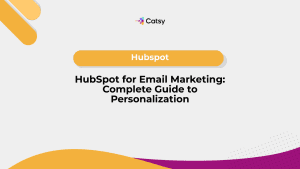Shopify + PIM: A Match Made for Multichannel Selling
Discover how PIM and Shopify work together to power multichannel selling. Learn how centralized product content drives consistency across Amazon, Walmart, and more.

Table of Contents
- Introduction
- The Multichannel Reality for Modern Shopify Merchants
- What Is Product Information Management (PIM)?
- Why Shopify Alone Isn’t Enough for Multichannel
- How PIM Powers E-commerce Content Syndication
- Real-World Channels Enhanced by Shopify + PIM
- Case Study: Scaling from Shopify to 5 Channels with Catsy
- Why Catsy is the Multichannel Captain for Shopify Merchants
- Conclusion
What You Will Learn
- How PIM enhances Shopify’s multichannel selling capabilities
- Where Shopify’s native tools fall short for content syndication
- Which marketplaces and channels benefit from PIM-powered listings
- How Catsy centralizes and syndicates your product data effortlessly
- Actionable insights into improving catalog consistency at scale
In this Article
1. Introduction
Compare running your Shopify store to captaining a sleek sailboat. When you begin selling on other channels (think Amazon, eBay, or Walmart) you’re no longer just charting a local voyage. You’ll need the tools to navigate global trade winds, shifting currents, and complex regulatory tides.
To stay afloat and get ahead, you’ll need more than just Shopify. You need a compass for your content and a crew that can ensure that your data sails smoothly, no matter where you intend to dock.
In short, you need a PIM. Together, Shopify and your PIM can form the ultimate multichannel duo: flexible on the front end, streamlined on the backend.
2. The Multichannel Reality for Modern Shopify Merchants
a. The Growing Complexity of Selling Everywhere
Customer journeys are increasingly growing to span new touchpoints. Marketplaces, social media, and direct to consumer shops are just a few! Shopify merchants are feeling the pressure to be everywhere at once.
But each channel has its own set of rules, formats, and content expectations:
- Amazon requires bullet points, EANs, and image specs
- Google Shopping wants short, structured descriptions
- eBay thrives on rich metadata and item specifics
- Facebook & Instagram favor visual-forward presentation
b. Why Product Information Consistency Matters
According to McKinsey, “Consistent, enriched product content across channels directly impacts customer trust, conversion rates, and loyalty.”
When your product descriptions, images, and specs are in alignment, your customers’ trust in your brand grows. To the contrary, inaccurate or missing data will quickly erode brand trust.
Make Catsy DAM and PIM Software an Extension of Your Team
Book a Free Demo3. What Is Product Information Management (PIM)?
a. Definition and Core Capabilities
Product information management software centralizes all of your product data into one structured system. This includes your specs, images, variants, compliance attributes, titles, and so much more!
PIM for Shopify merchants ensures that each of your sales channels receives accurate and relevant content that’s optimized for the destination.
b. PIM vs Traditional Product Management
Feature | Shopify Native | PIM + Shopify |
Description Editing | Per Product | Template & Bulk Rules |
Image Linking | Manual | DAM-Driven, Automated |
SEO Fields | Manual | Inherited or Validated |
Channel Syndication | Manual CSV/API | Pre-mapped Fields |
Language/Region Handling | Basic | Full Localization Tools |
A PIM can convert your vessel from a rowboat to a race-ready schooner and beyond. You’ll have the tools you need to scale with confidence.
4. Why Shopify Alone Isn’t Enough for Multichannel
a. Shopify Strengths & Limitations
Shopify is a beautiful platform in terms of payment processing, store design, and quick product launches. But when it comes to managing and syndicating your content across multiple channels, it just can’t keep up with a PIM.
Here’s why:
- There’s no central product data hub
- Metafields are powerful, but they’re tedious to scale
- Product images aren’t automatically linked across variants
- Marketplace integration requires apps or manual work
b. The Risks of Manual Data Management Across Channels
Without a PIM system, selling across multiple channels often leads to:
- Inconsistent product names and prices across your platforms
- Incomplete attributes (like missing material or dimensions) on Amazon
- SEO cannibalization from duplicate listings
- High return rates due to unclear or outdated descriptions
These challenges can slow down your ship, costing you revenue and frustrating your customers.
5. How PIM Powers E-commerce Content Syndication
a. Centralizing for Clarity
When you use a PIM, you create a single source of truth for all of your product data. Each product lives in a structured “home” with fields, tags, specs, and assets that are updated once – then used as many times as you need!
This central data source eliminates manual efforts and duplication, and it prevents mistakes.
b. Channel-Specific Optimization
Each channel you intend to list on has its own product data requirements. You may find that you have:
- Length-limited descriptions
- Specific required attributes
- Channel-preferred image sets
- Localized keywords and regulatory fields
With Catsy’s PIM, you can map content as it’s required for each channel. Maintain a clear overview of what’s live, what’s missing, and what’s optimized.
According to Plytix, e-commerce content syndication allows brands to reach new customers efficiently, increasing sales potential across multiple platforms.
c. Localization and Compliance
If you plan to expand internationally, PIM will be your first mate with respect to:
- Currency formatting
- Measurement units (such as inches vs centimeters)
- Country-specific compliance (Prop 65, CE)
- Translated product content for each market
Without this, launching into new regions becomes a turbulent, expensive voyage.
6. Real-World Channels Enhanced by Shopify + PIM
a. Amazon
PIM helps you:
- Maintain A+ content formatting
- Keep titles within Amazon’s length requirements
- Upload compliant imagery
- Dynamically manage parent-child relationships
b. Walmart Marketplace
Walmart has strict content requirements for:
- Bullet formatting
- Category-specific specs
- UPC/EANs
- Shipping and tax metadata
Catsy supports Walmart-specific templates so your compliant listings go live quickly.
c. eBay
With PIM you can:
- Automatically map item specifics
- Optimize for eBay search algorithms
- Sync dynamic pricing and availability
- Handle multiple condition fields (new, used, refurbished)
d. Google Shopping & Facebook
For high-volume feed channels, PIM tools can streamline:
- Feed formatting (CSV/XML)
- Google attributes like gtin, brand, condition
- Visual consistency across ad previews
- Dynamic product set tagging for Facebook/Instagram
- B2B Portals and Distributors
Do you sell through dealer networks, distributors, or product data pools? PIM ensures that each channel receives accurate, validated product data in their preferred format… automatically.
7. Case Study: Scaling from Shopify to 5 Channels with Catsy
Brand: ModernGear Outfitters
Industry: Outdoor Equipment
Starting Point:
- 350 SKUs in Shopify
- Manually listing to Amazon & eBay
- Frustrated by duplication, errors, and slow updates
Challenges:
- Each channel required unique titles, bullet points, and specs
- Hard to maintain consistency
- Shopify’s metafields weren’t scalable
Solution:
- Adopted Catsy PIM with Shopify integration
- Centralized all product data and assets
- Used channel templates for Amazon, Walmart, and Google
- Enabled rule-based metafield management
Results:
- Time-to-market dropped by 60 percent
- Return rate reduced by 22 percent due to increased accuracy of specs
- Revenue from non-Shopify channels grew 3x in six months
“Catsy gave us the wind we needed to expand. We went from two channels to five without increasing our team size.”
8. Why Catsy is the Multichannel Captain for Shopify Merchants
Catsy was purpose-built to bridge Shopify merchants like you to the world. Whether you’re syndicating to one or to one hundred channels, Catsy keeps your content shipshape.
a. Built for Shopify + Multichannel
- Native integration with Shopify Admin
- Metafield mapping and validation
- Shopify Markets support
- Real-time sync to Shopify and 3rd-party marketplaces
b. Unified PIM + DAM
- Manage product specs, descriptions, images, and videos
- Use tags, alt text, and channel-specific assets
- Eliminate file confusion with built-in Digital Asset Management
c. Channel Optimization Tools
- Channel-specific templates
- Custom field mapping
- Validation for required attributes
- Error flags for incomplete content
d. Speed, Scale, and Simplicity
- Rule-based enrichment
- Dynamic product families
- Bulk editing and scheduling
- Pre-built connectors for marketplaces and marketing feeds
9. Conclusion
That’s precisely what PIM offers: the ability to manage your catalog once time, then deploy it everywhere you wish to be found. Your customers – and you – will enjoy speed and consistency across each of your channels.
Shopify and PIM aren’t just compatible, they’re complementary. Together, these platforms can empower you to turn chaos into control. With Catsy at the helm, you can chart a course across each of your sales channels.
10. Key Takeaways
- Multichannel selling is no longer optional… it’s expected
- Shopify excels at storefront management, but lacks syndication tools
- PIM centralizes and customizes your product content for each channel
- Catsy simplifies multichannel expansion for Shopify merchants
- Consistency, speed, and scale come from one unified source of truth
Want more tips, tutorials, and insights on product content and e-commerce operations?
Stay connected. We post regularly to help brands like yours scale smarter.
Are You Ready To streamline your product content management?

11. Frequently Asked Questions
Content syndication for e-commerce is the process of distributing consistent data across multiple sales channels. This could include Amazon, Walmart, eBay, and Google Shopping. Formatting is tailored to each platform’s requirements.
Shopify can handle your storefront and your payment processing with ease. But your centralized product data, bulk editing, and syndication across marketplaces will falter without a PIM. Your product information management system enables consistent and scalable growth.
Yep! Catsy allows you to syndicate your product content from one single source of truth. Push your data to Shopify, Amazon, eBay, Walmart, and much more!
Catsy’s catalog management system organizes all of your SKUs, specs, images, and marketing content in one structured interface. This improves efficiency and reduces errors.
No way! Catsy offers scalable solutions for small and mid-sized Shopify stores that want to grow across channels without drowning in manual work.
Subscribe For More Content
Sign up for monthly tips on how to drive revenue with product content.




